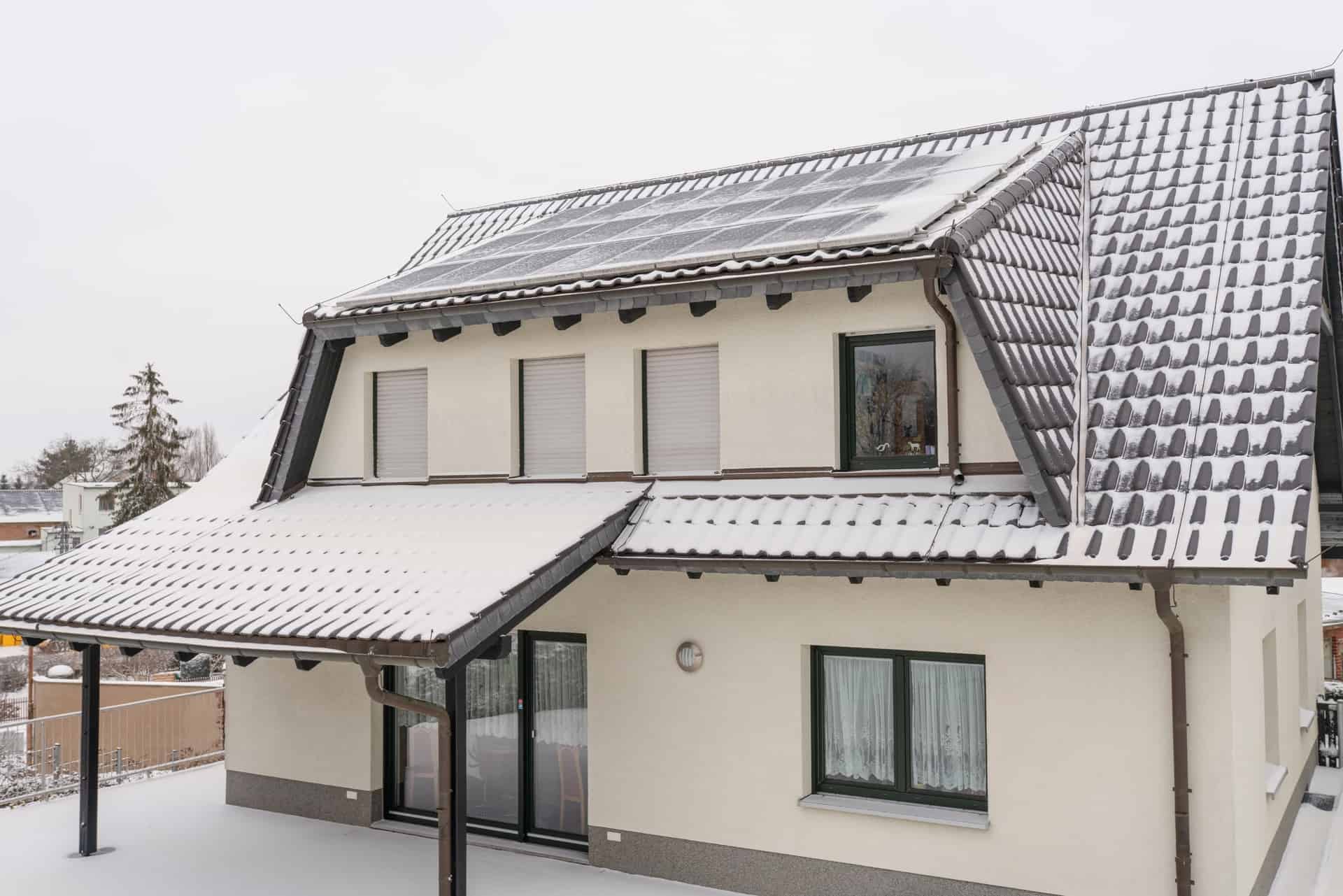
Can You Replace a Roof in the Winter?
GET A FREE INSPECTIONFree Roof Inspection
The winter season often comes with snowfall, high winds, extreme temperatures, and thawing that can be detrimental to your roof. These weather conditions lead to roof collapse, moisture, mold growth, gutters and downspout damage, and flashing leaks. Many homeowners wonder, "Can you replace a roof in the winter?" so we've tackled that question in this guide.
It’s always better to fix issues as soon as you notice them. That's why smart homeowners get roof inspections during the Fall to check for any problems that need to be addressed and to ensure their roof can withstand inclement weather during the winter.
However, there are still instances when your roof suddenly becomes damaged and requires immediate attention. Fortunately, you can replace a roof in the winter–but you shouldn’t try to do it yourself because it can be difficult and dangerous to work during inclement winter conditions.
Trust expert roofers to handle the job–they have the skills, experience, and tools to do it correctly and safely. At RoofClaim, we understand the challenges of repairing or replacing your roof in the winter and have experienced contractors with the necessary tools to do the job right.
Common Issues with Replacing a Roof in the Winter
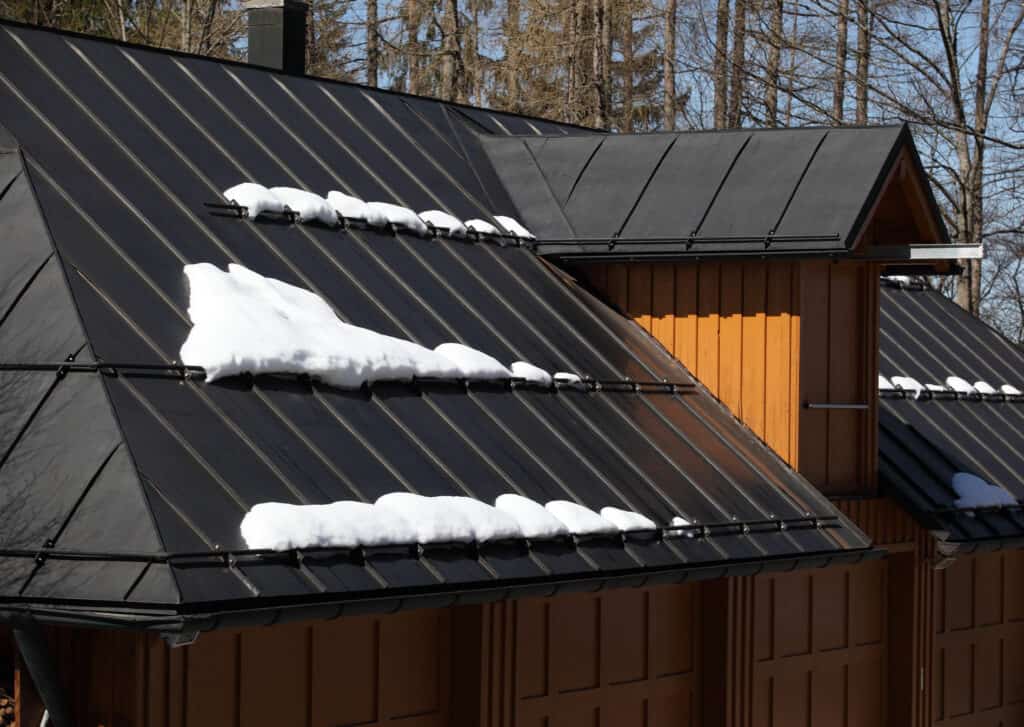
Keep in mind, without adequate experience and knowledge in handling roofing projects, it’s difficult to prevent accidents. When you work with roofclaim.com, we guarantee the best possible result for your roof and even offer a Million Dollar Guarantee.
Let’s take a look at some of the common issues you may encounter when replacing a roof during winter.
1. Cold Temperatures
Cold, icy weather can make it harder for roofing companies to help with repairs and roof replacement. Many roofing contractors understand that ice and snow may create hazardous situations making them more prone to slipping and falling.
2. High Wind Speeds
Aside from the cold and snow, the winter season also brings high wind speeds. Roofing is difficult enough in good conditions–adding wind to the mix makes it difficult for roofing crews to do their work.
Aggressive winds can also rip off the shingles and other roofing materials from your roof. High wind speeds have a habit of doing that even if it isn’t the winter season. This is especially true if your roof is older and worn down.
While roofclaim.com can handle replacing a roof in the winter, customers need to be aware of potential delays caused by inclement weather conditions.
3. Malfunctioning Tools & Materials
Harsh winter conditions don’t only make things difficult for roofers. Many of the tools and materials used in replacing a roof are sensitive to cold temperatures. For example, a nail gun and a compressor won’t work well under these conditions, since the cold can freeze the water in the airlines and block the airflow.
A roof replacement project also involves carrying large panels since the deck must be stripped off and replaced. Now, imagine doing this in the winter when the winds are cold and blowing from all sides. It’s a task that only experts can do.
Consider letting our professional roofers from roofclaim.com handle the job for you. We know how to prepare the tools and materials for winter use and have experience working in all weather conditions.
4. Cold and Brittle Shingles
Cold weather can also be bad news for your shingles and other roofing materials. That’s because some of them, such as fiberglass and asphalt shingles, become less flexible and turn brittle in cold temperatures.
Since these materials may be more difficult to bend and cut, roofers may experience difficulty using the racking method during the installation process. It’s also problematic when you’re laying shingles on the ridge caps, hips, and roof valleys, since these areas require a great deal of shingle manipulation.
To prevent the shingles from becoming brittle, it’s necessary to store them in a heated area that’s at least 70 °F for a minimum of 24 hours. If they become brittle, there is a high risk of the materials breaking or cracking when you drive the nails into them.
Roofers must be careful about how much pressure we release during the installation process and how we walk around on freshly installed shingles. Fortunately, our experienced roofing professionals know how to make sure the job gets done right in every type of weather.
5. Poor Adhesive Properties of Asphalt Shingles
Aside from the issues with brittleness, asphalt shingles have poor adhesive properties in the winter. During the Spring and Summer, the sealing strips have no trouble bonding with the surface of the roof. Once the temperature drops below 40 °F, the properties of these adhesives change, so shingles have a hard time sticking and providing optimum coverage on your roof.
If you want to stick with asphalt shingles, you should wait until the temperature becomes suitable for a roof replacement project. The only way to work around this issue is to choose another type of roofing material that doesn’t require adhesive.
Although they’re rare, some manufacturers now produce adhesive solutions that can be used in temperatures as low as 30 °F. Our team of roofing experts will take the weather conditions into consideration and offer the most suitable recommendations to get the best results for your roof.
6. Ice Dams
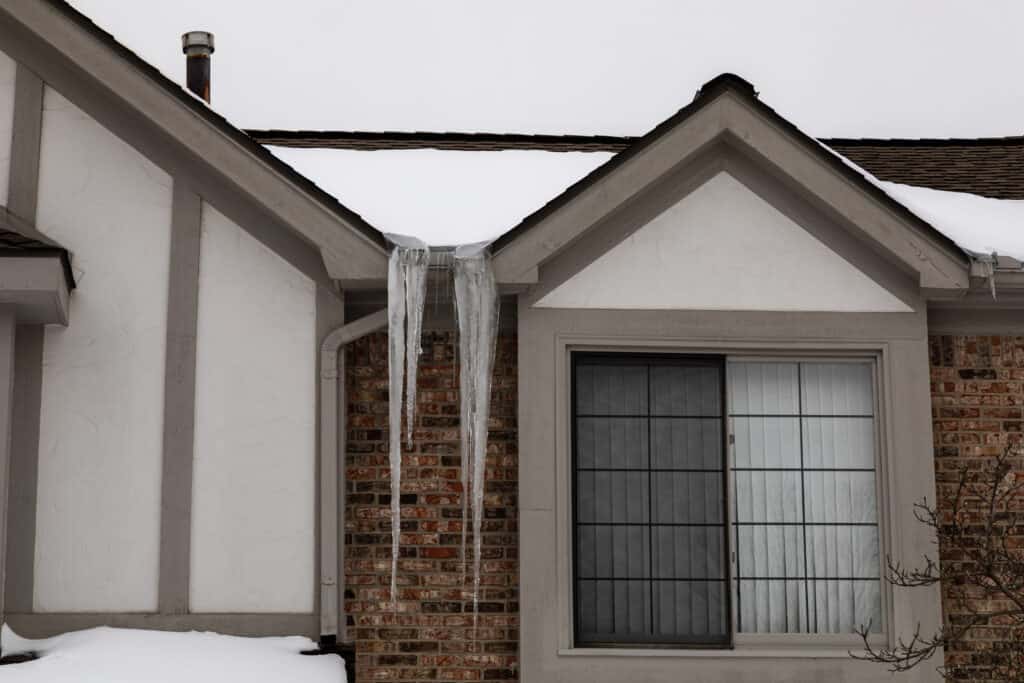
Ice dams are a common winter roofing problem that forms at the edge of a roof. This occurs when snow in the middle of the roof melts, runs down, then gets stuck in the still-frozen or clogged gutters. With nowhere to drain the melted snow, it will re-freeze and create a large dam of solid ice on the roof edges. It becomes a problem when another batch of snow melts and can’t drain properly because of the ice blockage.
Next, moisture can enter your home from those ice dams, and you’ll face mold and mildew growth that can cause respiratory issues. That is why it’s crucial to have annual roof inspections before the winter to address those issues and damages that could worsen in the upcoming months.
At roofclaim.com, we offer free roof inspections, comprehensive assessment reports, and help with insurance claims to ensure your home is protected.
7. Dangerous Tree Limbs
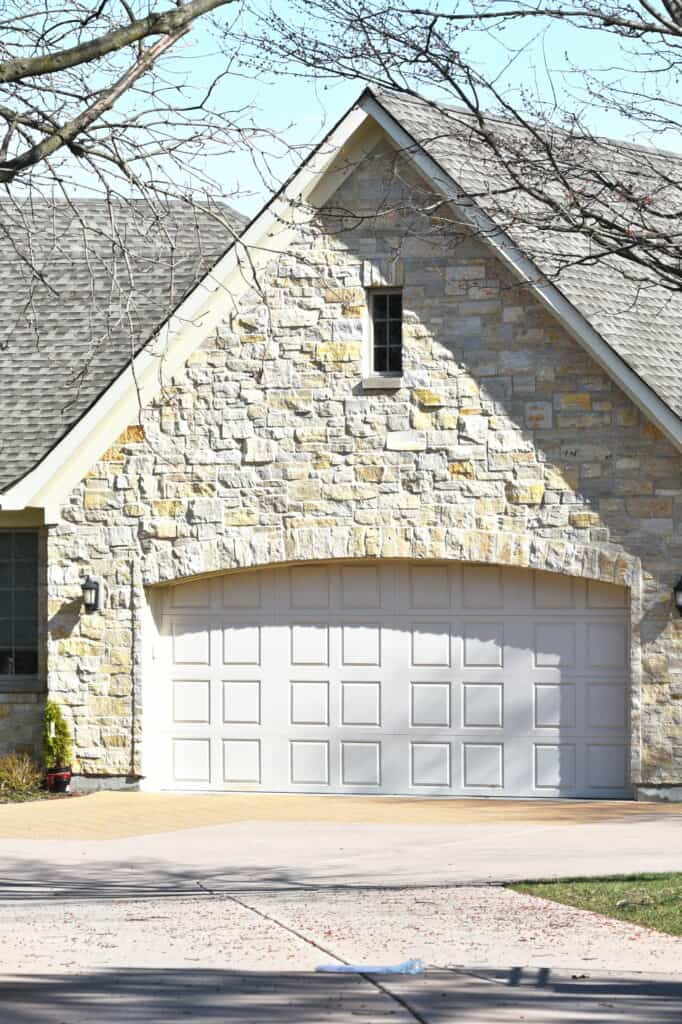
Houses that are surrounded by trees in their yards are blessed with beautiful scenery all year long. However, it comes with a few responsibilities and dangers. When there is a strong storm or blizzard, overhanging tree limbs can scrape the surface of your roof and cause damage to its top layers. In a worst-case scenario, a branch or the entire tree could fall and create holes in your roof.
To prevent these incidents from happening and protect your home, trim any branches within six feet of your home. It’s also a good idea to check the state of each tree and remove those that are dead, damaged, or diseased. This also helps keep pests and insects away from your roof and prevents them from building nests inside.
While branches and tree limbs close to the roof should be removed for general maintenance and protection, it’s definitely something you’ll want to consider having done prior to having your roof replaced.
8. Excessive Snow
Roofs are durable structures that protect your home and people from inclement weather. However, extreme weather like blizzards and winter storms leave a heavy load of snow and ice behind. When your roof is weak from years of use or isn’t properly designed to carry excessive snow loads, your roof is at risk of collapsing.
Fortunately, this roofing problem can be prevented. As soon as you notice a buildup of deep snow on your roof, it’s crucial to get it off as soon as possible. Don’t wait for the next winter storm to come and pile up another layer of snow.
If you do move forward with having your roof replaced in winter, and you live in an area with heavy snow conditions, you’re going to want to prepare to have your roof cleared of heavy snow as quickly as possible to protect your new investment.
9. Flashing Leaks
Roof flashings are the aluminum pieces around pipes, roof edges, skylights, vents, and chimneys. They help bridge the gaps between roofing materials and exposed surfaces to keep moisture out. A leaky flashing is a common roofing issue, especially in homes with a sloped roof. Although it can happen during any season, it’s a common issue in some homes during winter because of the freeze-thaw process.
To prevent this from happening during winter, inspect your flashing every year and check to see if it’s installed properly. Sometimes, a storm with violent and strong winds may pull it away from your roofing materials and open a gap for water leaks. At roofclaim.com, we will inspect your roof flashings and offer any necessary repairs.
10. Scheduling Delays
Installing a new roof can take longer during the winter because of snow and ice. Even if there’s only a light snowfall, it can be dangerous for the person climbing up and working on the roof. That’s why we carefully follow, check, and analyze the weather forecast to see how it will impact a roof replacement project.
Best Temperature for Roof Replacement
We can replace a roof during any season. However, most experts generally agree it’s not a good idea to repair or replace a roof when the temperature drops below 40 °F. A temperature that’s too cold can impact the end result of your roof improvement project.
Ideally, the best temperature and condition to do a roof replacement is around 55 °F with mild humidity. There should also be no rain and as little wind as possible.
While we can replace a roof in less than ideal conditions, it can make the replacement take longer. Most roof replacements only take a day, but inclement weather can certainly prolong that, so make sure you have realistic expectations.
Shingle Temperature During Roof Installation
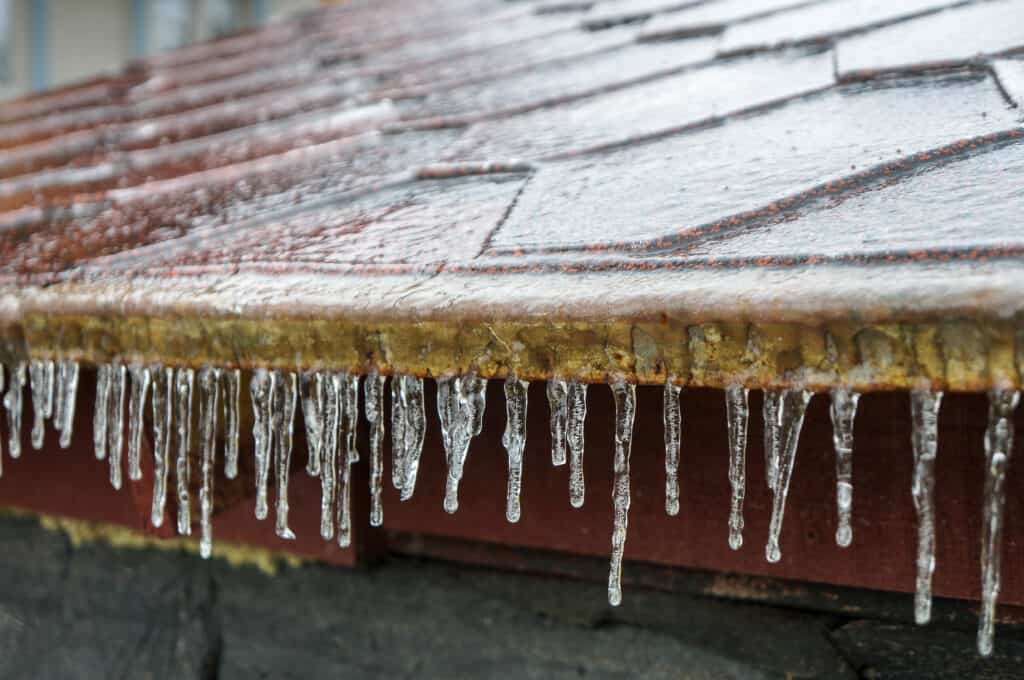
As mentioned before, shingles are sensitive to temperature. They may become brittle and crack while you are trying to install them on your roof during winter. It’s advisable to install new asphalt shingles on your roof when the temperature is between 40 to 85 °F.
If you’re under a time constraint and feel your roofing issue should be dealt with immediately, contact us for a consultation and let us handle the installation process. We have the necessary tools and experience to ensure the materials are safe and the job will be completed properly.
Does Colder Temperatures Make Roof Replacements Longer?
Yes, colder temperatures can make roof replacements longer, as the cold weather can affect the materials used in the installation process and can slow down the work. For example, in colder temperatures, asphalt shingles can become brittle and difficult to work with, which can make them more prone to cracking or breaking during installation. The adhesive used to attach the shingles can also become less effective, which can cause the shingles to lift or come loose in high winds.
Additionally, when working in colder temperatures, workers may need to take extra precautions to avoid slipping or falling on icy or snow-covered surfaces. This can slow down the work and increase the risk of injury.
Proper Shingle Sealing During Winter
The process of bonding new shingles to a roof is different during the winter. Similar to the material’s strength, the shingles’ adhesive properties are affected during the coldest months of the year.
Adhesives play a critical role in keeping the entire system intact, but they don’t stick well when it’s cold. To properly seal them in place, professional roofing contractors often choose to hand-seal using specially formulated adhesives or asphalt roofing cement.
The Bottom Line: Replacing a Roof in the Winter
No matter the season, a roof replacement project is best handled by professionals. There’s a high risk of getting in an accident and making the damages even worse if you try to handle it on your own.
We offer free roof inspections and guarantee professional service from start to finish in all types of weather. Schedule a free inspection with us so we can inspect your roof, identify any concerns, and offer the best approach to solve your individual roofing issues. If you have questions prior to scheduling an inspection, feel free to contact us. We’re happy to help!

